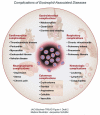Workshop report from the National Institutes of Health Taskforce on the Research Needs of Eosinophil-Associated Diseases (TREAD)
- PMID: 22935587
- PMCID: PMC3432981
- DOI: 10.1016/j.jaci.2012.07.024
Workshop report from the National Institutes of Health Taskforce on the Research Needs of Eosinophil-Associated Diseases (TREAD)
Abstract
Background: Eosinophils are blood cells that are often found in high numbers in the tissues of allergic conditions and helminthic parasite infections. The pathophysiologic roles that eosinophils may serve in other human "eosinophil-associated" diseases remain obscure.
Objective: National Institutes of Health (NIH) Institutes and the Office of Disease Prevention assembled an international taskforce of clinical and basic scientists with the charge to propose and prioritize unmet research needs in eosinophil-associated diseases.
Methods: The taskforce used an organ system approach to identify the different and common themes of eosinophil cell involvement in these diseases. In early 2012, a draft document was circulated for review. The document was amended and the prioritizations were set at a NIH-organized workshop in June 2012.
Results: The taskforce identified significant research needs. These needs cross disease entities but some are disease specific. There are substantial shortcomings to the various preclinical animal models, as well as significant gaps in our epidemiologic, pathophysiologic, diagnostic, prognostic, and therapeutic knowledge. The taskforce recognized that recent efforts by patient advocacy groups have played instrumental roles in improving the identification and characterization of these disorders. However, communications among the eosinophil-interested communities, for example, governmental funding and regulatory agencies, and industry and clinician scientists need to be more comprehensive.
Conclusions: Significant efforts are required to address our knowledge gaps to improve the outcomes of eosinophil-associated diseases. NIH Institutes, other federal agencies, lay organizations, and the pharmaceutical industry should consider the taskforce's recommendations in their future research activities.
Copyright © 2012 American Academy of Allergy, Asthma & Immunology. Published by Mosby, Inc. All rights reserved.
Figures
References
-
- Tulic MK, Andrews D, Crook ML, Charles A, Tourigny MR, Moqbel R, et al. Changes in thymic regulatory T-cell maturation from birth to puberty: differences in atopic children. J Allergy Clin Immunol. 2012;129:199–206. e1–4. - PubMed
Publication types
MeSH terms
Grants and funding
LinkOut - more resources
Full Text Sources
Medical


